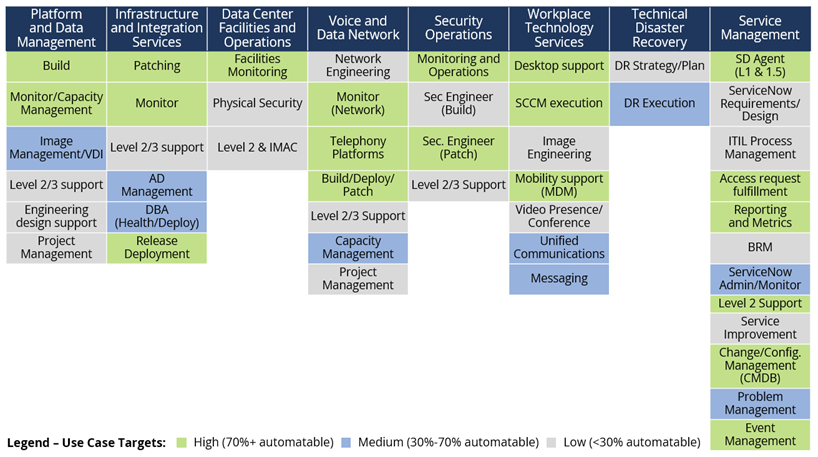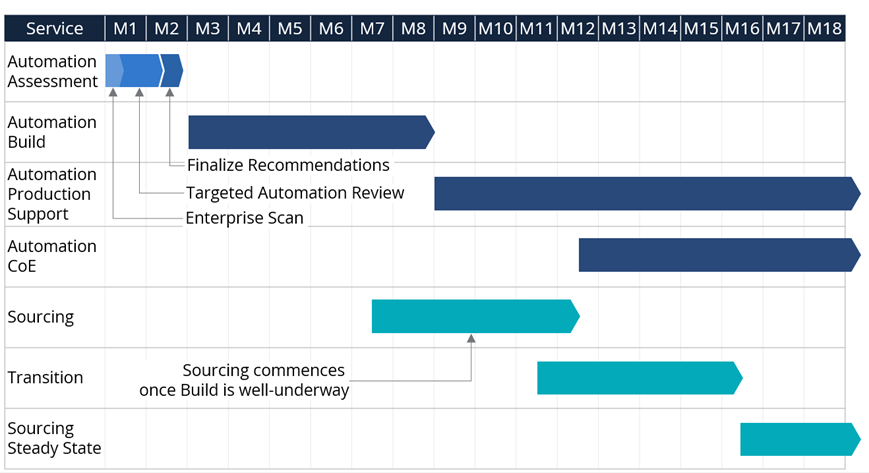Whether you run your own in-house IT shop or have been sourcing with managed service providers for decades, everyone is trying to figure out the best way to manage costs, increase agility and provide outstanding customer service in this digital age. The challenges abound: technical debt associated with aging legacy environments, the “Great Resignation” affecting your access to talent and rapidly changing customer expectations are just a few.
ISG Automation has developed a methodology called “Assess to Automate to Source” (AtAtS) that brings a new mindset to solving some of those most pressing issues.
Looking for Automation Opportunities
The simplest way to explain the AtAtS approach is to look for as many opportunities as possible to reduce human labor in day-to-day IT operational functions. The goal is to free up critical resources so they can focus on higher-value activities that support business objectives. The AtAtS concept applies equally to many business-related operational functions such as Procure to Pay, Order to Cash, Record to Report, Supply Chain and Human Resources.
When considering the AtAtS approach, it is important to understand the “art of the possible.” Many processes in IT operations can now be easily performed via intelligent automation. The table below shows potential automation-related opportunities for common IT functions.

Figure 1: Infrastructure-related Automation Opportunities
For each of these functions, consider the current staffing costs and operational challenges caused by inefficient and unaligned processes. With intelligent automation, these functions can be partially, mostly or completely fulfilled. What would be the value of reallocating staff and costs to higher-value activities? How would end user and/or customer satisfaction be improved with faster and more accurate processing?
The following are three types of IT processes that represent opportunities to automate and streamline:
- Issue resolution: password resets, ticket management, troubleshooting, restarts, etc.
- Service requests: ID requests, software requests, hardware requests, BYOD enrollment, employee onboarding/offboarding, etc.
- Ongoing delivery processes (weeks/months): moves/changes, testing, dev/ops, patching, problem management, reporting, etc.
Owning Your Automation Program
If you work with managed service providers today, you are probably thinking they will automate as much as possible to reduce costs and improve services. The reality is not that simple. While all providers offer various levels of automation and build it into their delivery models, the bottom line is that labor arbitrage is still their primary lever, and they are all looking to grow and expand their substantive offshore delivery centers. They will commit to lower prices and/or increased service levels in response to the market, but “how” they achieve their savings is more or less behind the curtain.
Why is labor arbitrage still such a driver?
The primary answer is that many of these companies were founded based on the promise of labor arbitrage – it is what they know and what they do best. The financial risks associated with labor-based delivery models and contracts are well-understood. A solution built on automation capabilities and future productivity is much riskier for them, especially when factoring in how quickly automation-related technologies are changing. There are other factors as well, including social and governmental incentives for continuing to build their teams.
You may now be thinking “why do I care how they reduce cost and/or improve delivery, as long as they do it?” It’s a fair question, but for most clients the answer is simple once you think about it. You should maintain ownership and control of your automation practice! Automation providers can help you establish your automation program or automation center of excellence (CoE), supplement your automation build capacity and even provide ongoing production support for the automation that is in production.
This type of third-party support is much different in terms of scale and scope than a typical large managed services arrangement. It is focused solely on helping you manage and deliver your own automations as opposed to those embedded in a provider’s overall delivery model. When you own the automations, you have much greater ability to manage the amount of third-party support you require over time.
Transitioning to an Automation-Focused Organization
The AtAtS approach leads to a more automation-focused organization. While exact timing can vary, a journey typically looks something like this, from month one to month 18:

Figure 2: Example Transition Timeline
The following chart outlines the various services associated with an automation journey, including specific goals for each phase.
|
Service |
Description |
|
Automation Assessment |
|
|
Automation Build |
|
|
Automation Production Support |
|
|
Automation CoE |
|
|
Sourcing |
|
|
Transition |
|
|
Sourcing Steady State |
|
Real World Examples of the Assess-to-Automate Approach
A couple of recent real-world use cases help illustrate the value of the AtAtS approach.
|
Use Case 1: Client X – Automation-based solution to reduce costs in service desk and IT operations |
|||||
|
Base Costs |
Cost to Achieve |
Run Rate Impact |
Staff Reduction |
Other Identified Benefits |
|
|
$130M/year |
$15M |
($14M)/year |
~45% |
Improved delivery quality and process standardization yielding ~$95M/year “soft savings” through reduced time required of store managers |
|
|
Use Case 2: Client Y – Automation-based solution to reduce costs in service desk and IT operations |
|||||
|
Base Costs |
Cost to Achieve |
Run Rate Impact |
Staff Reduction |
Other Identified Benefits |
|
|
$70M/year |
$5M |
($10M)/year |
~60% |
More ownership and control of IT services, with services and processes aligned to business operations |
|
Note that these examples do not include the additional savings associated with sourcing/re-sourcing of the remaining scope. Conservatively, this would reduce the base costs by an additional 20-40%.
Benefits of the Assess-to-Automate-to-Source Approach
ISG believes an assess-to-automate-to-source approach is the right approach for many clients. It allows you to:
- Quickly extract value from your legacy investments in technology
- Focus on identifying and prioritizing the most beneficial opportunities to automate IT and BPO functions
- Build your sourcing requirements based on a reduced footprint of scope of services as automation-based solutions are built and implemented
- Build a relationship with an automation provider and retain your critical and key employees to develop your automation strategy and roadmap while allowing the professionals from an automation provider to create and maintain your automation CoE and drive continued improvements across IT and business functions
- Commence a sourcing event aligned to your updated (and reduced) requirements and expectations as automations are being designed and built
Benefits of this approach include:
- Realizing the efficiencies and benefits of automation prior to sourcing
- Ensuring your automation program is a strategic capability rather than moving to a managed services provider
- Reducing the scope of the work to be sourced (or retained by your team) by 30%-60%
ISG recommends conducting a six- to eight-week automation assessment to identify high-value automation opportunities and lay out how an automation-first approach can yield considerable improvements and savings in your organization. Let us help you understand what’s possible and what an AtAtS journey may look like for you.
